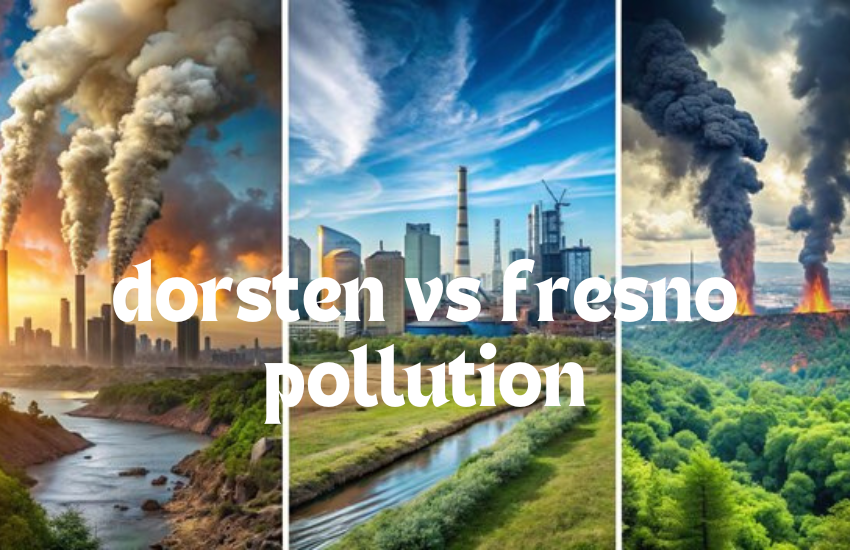Introduction to Dorsten vs Fresno Pollution Comparison Chart
Welcome to an intriguing exploration of Dorsten vs Fresno Pollution Comparison Chart: Dorsten, Germany, and Fresno, California. Both cities offer unique lifestyles and environments but face their own challenges when it comes to pollution. As urban areas continue to grow, understanding how each city manages its environmental impact becomes increasingly important.
In this post, we will dive into a detailed comparison chart that breaks down the sources of pollution in both locations. We’ll examine air quality metrics and water safety standards while considering the implications for public health. Whether you’re a resident or simply curious about these locales, this analysis sheds light on what you need to know about Dorsten and Fresno’s ecological footprints!
Sources of Pollution in Dorsten and Fresno
Dorsten and Fresno each grapple with distinct pollution sources. In Dorsten, industrial activities are a significant contributor. Factories release emissions that affect local air quality. Additionally, transportation plays a role, particularly from diesel vehicles.
Fresno faces its own challenges as well. Agriculture is a major industry here, leading to pesticide runoff and particulate matter in the air. The Central Valley’s geography often traps pollutants, exacerbating issues.
Both cities experience construction-related dust and debris too. Urban development can increase noise and air pollutants simultaneously.
In terms of waste management, Dorsten has made strides but still encounters challenges from waste incineration processes. Conversely, Fresno struggles with landfill overflow impacting not only soil but also groundwater quality.
Understanding these specific sources helps paint a clearer picture of the environmental landscape each city navigates daily.
Air Quality Comparison between Dorsten and Fresno
Air quality is a critical factor in understanding pollution levels. In this comparison, Dorsten and Fresno present striking differences.
Dorsten benefits from its location in Germany, where stringent environmental regulations help maintain healthier air quality. The city often enjoys clear skies and reduced smog levels due to these proactive measures.
Fresno, on the other hand, faces unique challenges. Located in California’s San Joaquin Valley, it experiences higher concentrations of ground-level ozone and particulate matter. Geographical factors contribute significantly to this issue.
Seasonal changes also play a role. During summer months, Fresno’s air can become particularly polluted due to temperature inversions that trap pollutants close to the surface.
Monitoring systems indicate that residents of each city experience varying degrees of exposure to harmful airborne substances—each with distinct implications for health and wellbeing.
Water Quality Comparison between Dorsten and Fresno
When examining water quality, Dorsten and Fresno present striking contrasts. Dorsten benefits from stringent EU regulations that ensure safe drinking water standards. Residents often enjoy clean tap water sourced from underground aquifers.
Fresno, on the other hand, faces challenges with its water supply. Agricultural runoff frequently contaminates local sources. This can lead to elevated levels of nitrates and pesticides in the drinking water.
Both cities have initiated monitoring programs to address these concerns. In Dorsten, regular testing keeps residents informed about any changes in their water quality. Meanwhile, Fresno has implemented filtration systems to mitigate contamination risks.
Public awareness is also rising in both locations regarding sustainable practices for maintaining clean waterways. Community efforts play a vital role in promoting better management of resources and encouraging responsible usage among residents.
Impact of Pollution on Health in Dorsten and Fresno
Pollution in both Dorsten and Fresno significantly affects public health. In Dorsten, residents face challenges from industrial emissions and vehicle exhaust. Studies indicate increased respiratory issues among locals, particularly children and the elderly.
Fresno struggles with air quality due to its geographic location, trapping pollutants. High levels of ozone can lead to chronic conditions like asthma. The city’s agricultural practices also contribute to pesticide exposure.
Both cities experience a rise in cardiovascular diseases linked to pollution levels. Mental health issues are emerging as a concern too; anxiety often arises from environmental stressors.
Access to healthcare plays a role in how communities cope with these impacts. While healthcare facilities are available, disparities exist that affect treatment outcomes for pollution-related illnesses in both areas.
Efforts to Reduce Pollution in Dorsten and Fresno
Dorsten has implemented several initiatives aimed at improving air quality. The city promotes cycling and public transport as eco-friendly alternatives to car travel. Local authorities encourage residents to adopt greener practices, such as using electric vehicles.
Fresno faces its own challenges with pollution but is proactive in addressing them. The city participates in numerous programs designed to enhance air quality through tree planting and urban greening projects. These efforts aim not only to absorb pollutants but also to beautify the community.
Both cities have launched educational campaigns focused on raising awareness about pollution’s impact. Residents are urged to reduce waste, recycle more, and choose sustainable products whenever possible.
Collaboration among local governments, businesses, and citizens plays a crucial role in these efforts. By working together, Dorsten and Fresno strive for cleaner environments while fostering healthier communities for future generations.
Conclusion: Which City is More Polluted?
When analyzing the pollution levels in Dorsten and Fresno, it’s clear that both cities face significant challenges, but they differ in their specific sources and types of pollution. Air quality issues in Fresno are primarily driven by vehicle emissions and agricultural activities, while Dorsten grapples with industrial discharges and urbanization.
Water quality presents a similar contrast. Fresno has struggled with water contamination from agricultural runoff, whereas Dorsten’s waterways face threats from industrial spills. Both cities have ongoing initiatives to combat these environmental issues, but the effectiveness varies based on local policies and community engagement.
Health impacts linked to pollution reveal a grim reality for residents in both areas. Increased respiratory diseases related to air quality affect people living in Fresno more frequently, while those in Dorsten may experience health problems stemming from contaminated water supplies.
In terms of efforts to reduce pollution, each city is taking steps forward—Fresno through stricter regulations on emissions and waste management initiatives; Dorsten through investment in green technology and infrastructure improvements.
Determining which city is more polluted requires a nuanced understanding of various factors at play. Each city’s unique circumstances contribute to its overall environmental footprint as well as the well-being of its inhabitants. The dorsten vs fresno pollution comparison chart highlights these complexities vividly.







